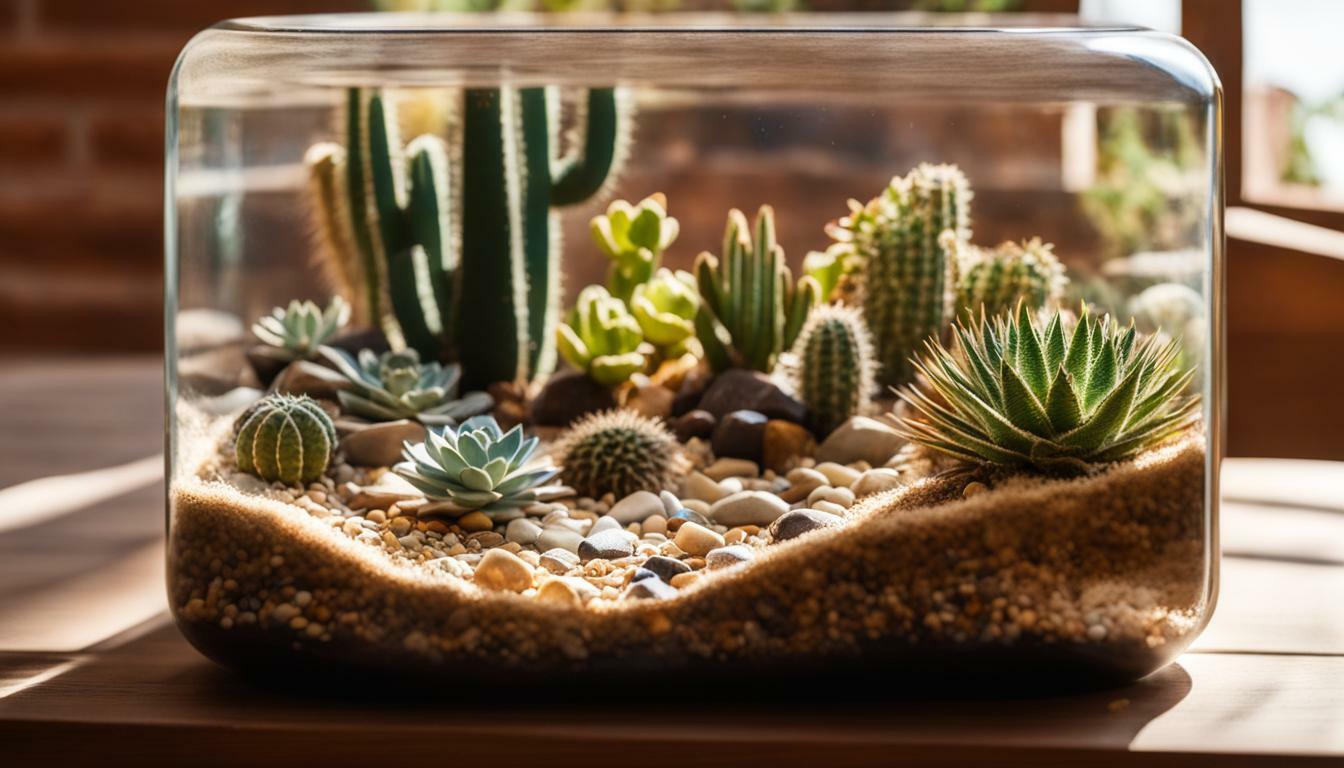Desert terrariums offer a unique opportunity to bring the beauty of arid landscapes into your home, creating a vibrant and low-maintenance ecosystem. With careful attention to key factors such as lighting, heating, humidity, watering, substrate, decor, and plant selection, you can create a stunning desert oasis right in your living space.
Creating a successful desert terrarium starts with ensuring proper lighting and heating. Providing high/bright lighting using full-spectrum grow lights or placing your terrarium near a bright window with indirect sunlight will mimic the arid environment that desert plants thrive in. In colder environments, additional heating may be necessary to maintain optimal conditions.
To mimic the low humidity levels of a desert, it’s important to monitor and maintain a dry environment within your terrarium. Watering should be done sparingly, only when the soil is completely dry. This will help prevent moisture-related issues that can harm your desert plants.
Choosing the right substrate and decor is crucial for creating an authentic desert look. Sandy substrates mixed with loam are recommended to ensure proper drainage, while rocks and wood pieces add visual appeal and mimic natural desert elements.
When it comes to plant selection, opt for slow-growing cacti, dry grasses, and drought-tolerant succulents. Limiting the number of plant species and leaving bare areas will help maintain the sparseness and natural aesthetic of a desert landscape.
By following these care tips and design ideas, you can create a beautiful and low-maintenance desert terrarium that brings the allure of the desert into your home.
Key Takeaways:
- Proper lighting and heating are essential for creating an arid environment in your desert terrarium.
- Maintaining low humidity levels is crucial to mimic the dry conditions of a desert.
- Watering should be done sparingly and only when the soil is completely dry.
- Choose sandy substrates mixed with loam for good drainage and use rocks and wood pieces for added decor.
- Select slow-growing cacti, dry grasses, and drought-tolerant succulents as ideal plants for your desert terrarium.
Understanding the Key Factors for Desert Terrarium Success
Creating a successful desert terrarium requires attention to key factors such as lighting, heating, humidity, watering, substrate, decor, and plant selection. By understanding and implementing these factors, you can create a beautiful and thriving ecosystem that mimics the arid conditions of a desert.
When it comes to lighting, providing high/bright lighting is essential for desert terrariums. Consider using full-spectrum grow lights or placing the terrarium near a bright window with indirect sunlight. This will ensure that your desert plants receive the adequate light they need to thrive.
Additionally, heating may be necessary, especially in colder environments. Maintaining a stable temperature within the terrarium will create the ideal conditions for desert plants to flourish. Monitor the temperature regularly and make adjustments as needed to ensure optimal growth.
To mimic the arid environment, it is crucial to maintain low humidity levels in the terrarium. Desert plants thrive in dry conditions, so avoid overwatering and ensure proper ventilation to prevent excess moisture buildup. A hygrometer can be useful for monitoring humidity levels and making necessary adjustments.
When it comes to watering, it’s important to remember that desert plants are adapted to survive with limited water. Water sparingly and only when the soil is completely dry. Overwatering can lead to root rot and other issues, so it’s best to err on the side of underwatering when caring for your desert terrarium.
| Substrate | Decor | Plant Selection |
|---|---|---|
| Sandy substrate with the addition of loam promotes proper drainage, ensuring that excess water doesn’t accumulate. | Rocks and wood pieces can be used to create an authentic desert landscape and add visual appeal to your terrarium. | Choose slow-growing cacti, dry grasses, and drought-tolerant succulents for your desert terrarium. These plants are well-suited to arid conditions and will thrive in your ecosystem. |
Limit the number of plant species in your terrarium to maintain a natural appearance. By leaving bare areas, you can mimic the sparseness of a desert landscape and create a visually pleasing arrangement within your terrarium.
By paying attention to the key factors of lighting, heating, humidity, watering, substrate, decor, and plant selection, you can create a beautiful and low-maintenance desert terrarium that brings the beauty of the desert into your home. Let your creativity flourish and enjoy the satisfaction of creating a unique ecosystem that showcases the resilience and beauty of desert plants.
Additional Resources:
Lighting and Heating for Desert Terrariums
Proper lighting and heating are essential for creating a desert-like environment in your terrarium. To mimic the arid conditions of a desert, it’s important to provide high/bright lighting using full-spectrum grow lights or by placing the terrarium near a bright window with indirect sunlight. This will ensure that your desert plants receive the necessary light to thrive.
In addition to lighting, you may also need to consider additional heating for your desert terrarium, especially if you live in a colder environment. Cold temperatures can be detrimental to desert plants, as they are typically used to warm climates. To maintain the optimal temperature, consider using a heat mat or a small heater specifically designed for terrariums.
By combining the right lighting and heating, you can create an environment that closely resembles the natural habitat of desert plants. This will not only enhance the beauty of your terrarium but also promote the health and growth of your plants.
Tips for Lighting and Heating:
- Use high/bright lighting with full-spectrum grow lights or position the terrarium near a bright window with indirect sunlight.
- Consider additional heating, such as a heat mat or small terrarium heater, to maintain the optimal temperature for desert plants.
- Monitor the temperature regularly and make adjustments as needed to ensure the well-being of your terrarium plants.
Creating a desert-like environment in your terrarium requires attention to detail, but with the right lighting and heating setup, you can achieve a beautiful and thriving desert ecosystem.
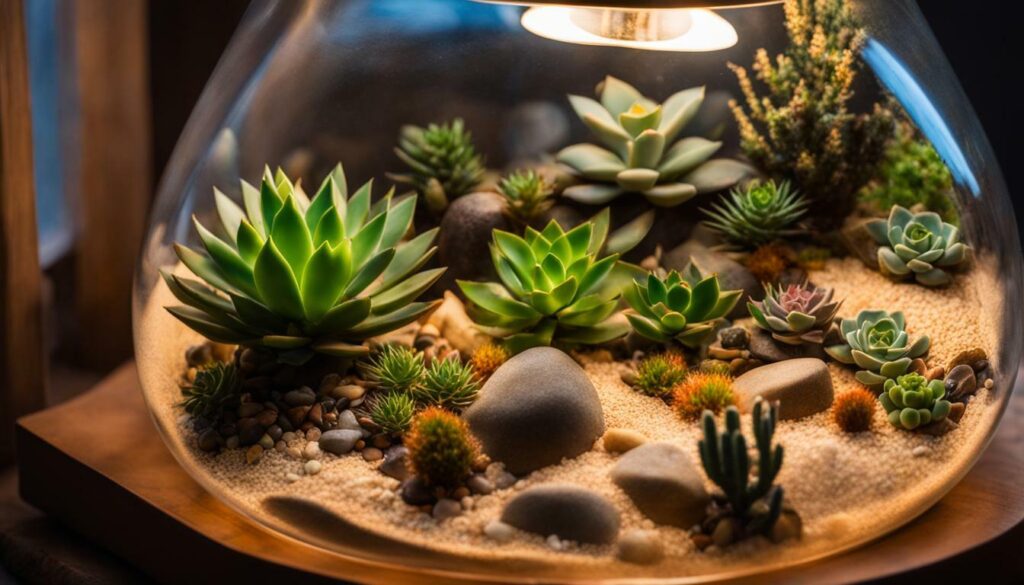
Desert terrariums require low humidity levels to replicate the arid conditions of a desert environment. High humidity can be detrimental to desert plants, leading to root rot and other issues. Maintaining the right humidity balance is crucial for the health and survival of the plants in your terrarium.
To achieve low humidity levels, there are several steps you can take. Firstly, ensure proper ventilation within the terrarium. Good air circulation helps to prevent moisture buildup and keeps the humidity in check. Consider adding small vents or cracks to the terrarium lid or sides to allow for the exchange of air.
Additionally, using a well-draining substrate can help to regulate humidity levels. Sandy substrates with the addition of loam provide good drainage, preventing water retention and minimizing the risk of excessive moisture in the terrarium. This type of substrate allows water to pass through easily, reducing the likelihood of humidity spikes.
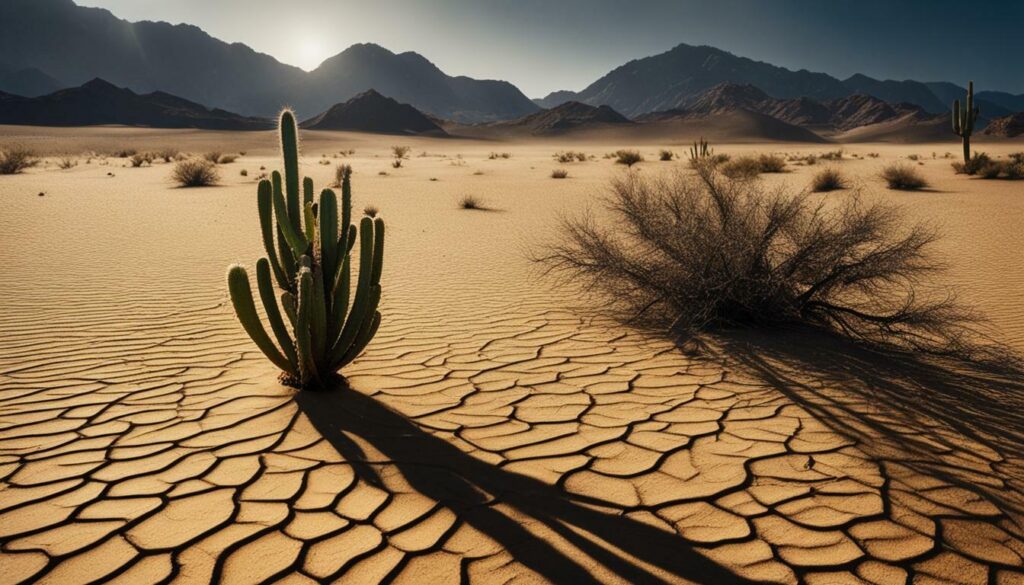
It’s also important to avoid overwatering your desert terrarium. Water sparingly and only when the soil is completely dry. This will help to prevent excess moisture from accumulating and causing humidity levels to rise. Remember that desert plants are adapted to survive in arid conditions and do not require frequent watering like other houseplants.
By paying attention to these measures and monitoring humidity levels regularly, you can create an environment that closely resembles the arid conditions of a desert. This will provide the optimal growing conditions for your desert plants, ensuring their health and longevity in your beautiful desert terrarium.
Watering Considerations
When it comes to watering your desert terrarium, less is more – only water when the soil is completely dry. Desert plants have adapted to survive in arid conditions, and overwatering can be detrimental to their health. It’s important to mimic the natural rainfall patterns of a desert by providing infrequent but deep waterings.
Table 1: Watering Guidelines for Desert Terrariums
| Plant Type | Watering Frequency |
|---|---|
| Slow-growing cacti | Once every 2-3 weeks |
| Dry grasses | Once every 1-2 weeks |
| Drought-tolerant succulents | Once every 1-2 weeks |
These are general guidelines, and it’s important to monitor the moisture level of the soil before watering. Stick your finger about an inch into the soil – if it feels dry, it’s time to water. Avoid overwatering, as it can lead to root rot and other issues.
Remember, desert terrariums are low-maintenance ecosystems that thrive on neglect. By providing the right amount of water at the right time, you can create a beautiful and sustainable desert landscape.
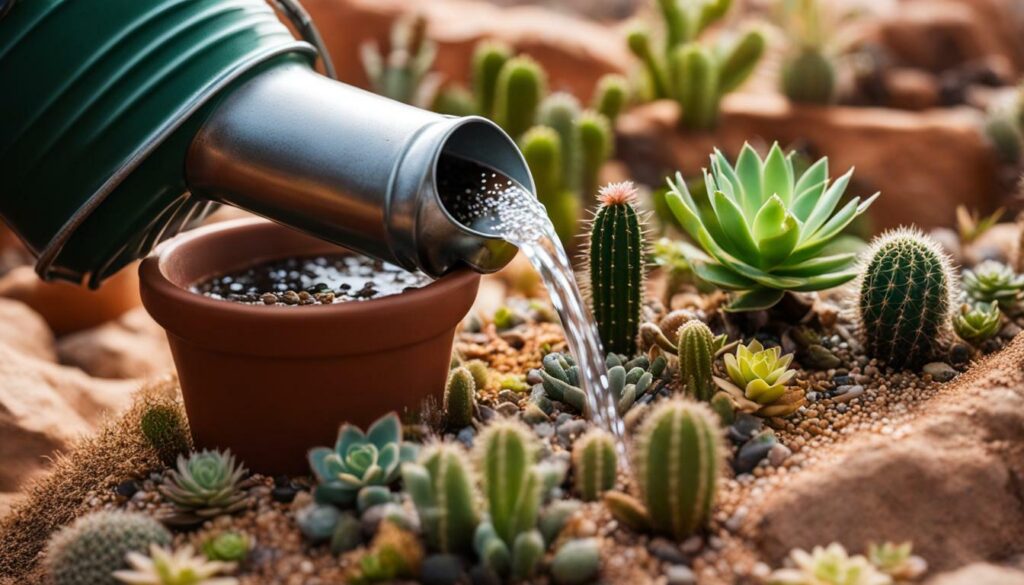
The substrate and decor choices play a crucial role in creating an authentic desert terrarium. A sandy substrate mixed with loam is recommended to ensure proper drainage and mimic the arid soil found in deserts. This type of substrate allows excess water to drain freely, preventing root rot and creating a more suitable environment for desert plants. The sandy texture also adds visual appeal, resembling the sandy dunes found in desert landscapes.
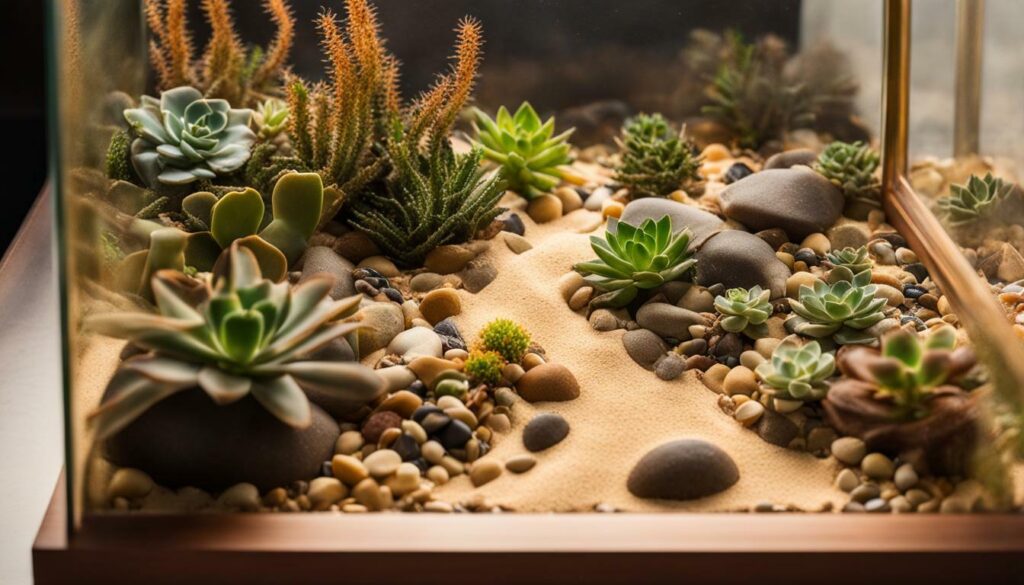
In addition to the substrate, the right decor elements can enhance the overall look of your desert terrarium. Incorporating rocks and wood pieces can create a natural and realistic landscape. Choose rocks of various sizes and shapes to resemble the rugged terrain of a desert. Placing them strategically within the terrarium not only adds visual interest but also provides spots for plants to anchor their roots.
Wood pieces, such as driftwood or bonsai branches, can further enhance the desert theme. These elements mimic the skeletal remains of desert plants and add a touch of authenticity to your terrarium. Be sure to choose pieces that are safe to use in the terrarium environment, free from harmful chemicals or treatments.
Table 1: Recommended Substrate and Decor for a Desert Terrarium
| Substrate | Decor |
|---|---|
| Sandy substrate mixed with loam | Various-sized rocks |
| – | Wood pieces (e.g., driftwood, bonsai branches) |
By choosing the right substrate and decor, you can create an authentic and visually appealing desert landscape in your terrarium. Remember to prioritize proper drainage with a sandy substrate mixed with loam, and incorporate rocks and wood pieces to mimic the natural elements of a desert. With these choices, your desert terrarium will be transformed into a stunning miniature desert oasis.
Selecting the Perfect Desert Plants
Choosing the right plants is key to creating a beautiful desert terrarium that thrives with minimal maintenance. Slow-growing cacti, dry grasses, and drought-tolerant succulents are ideal choices for this arid ecosystem. These plants are well-suited to the low-water conditions of a desert, making them perfect for a terrarium environment.
Slow-growing cacti, such as the popular Echinocactus grusonii or “Golden Barrel” cactus, provide a striking focal point with their spherical shape and spiky appearance. These cacti require minimal watering and prefer bright sunlight, making them an excellent choice for a desert terrarium.
Dry grasses, like the Festuca glauca or “Blue Fescue,” add texture and movement to the terrarium landscape. These ornamental grasses thrive in arid conditions and provide a natural look reminiscent of a desert prairie. With their blue-green foliage, they create a visually appealing contrast to other plants in the terrarium.
Drought-tolerant succulents, such as the Aloe vera or “Aloe,” are excellent choices for their ability to store water in their leaves. These plants add a touch of elegance with their fleshy leaves and vibrant colors. They are known for their low-maintenance nature and can tolerate dry, hot conditions, making them a perfect fit for a desert terrarium.
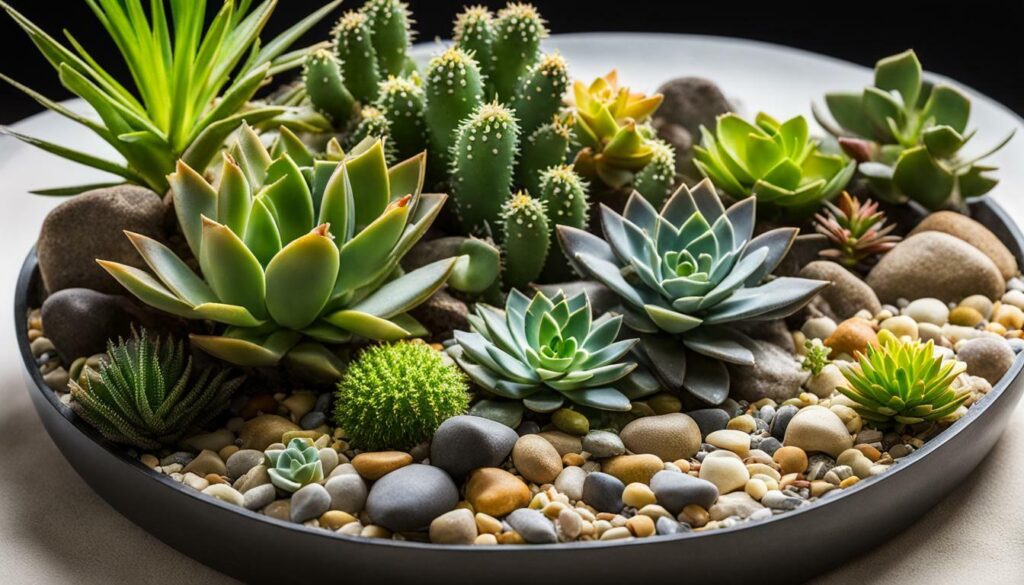
When selecting plants for your desert terrarium, it is essential to limit the number of species to maintain a natural appearance. Leaving empty spaces in the terrarium mimics the sparseness of a desert landscape and creates a visually appealing composition. By choosing slow-growing cacti, dry grasses, and drought-tolerant succulents, you can achieve a beautiful and low-maintenance desert terrarium that brings the beauty of the desert into your home.
Design Ideas for Vibrant Desert Terrariums
Get inspired by these design ideas to create a stunning and vibrant desert terrarium in your home. With careful attention to detail and the right elements, you can transform a simple glass container into a mini desert oasis that will captivate the eye and bring a touch of nature indoors.
Start by selecting a variety of desert plants that thrive in arid conditions. Opt for slow-growing cacti, such as the prickly pear or the golden barrel cactus, to add height and texture to your terrarium. Combine them with dry grasses like the blue fescue or the Mexican feather grass, which sway gently in the breeze, creating a sense of movement.
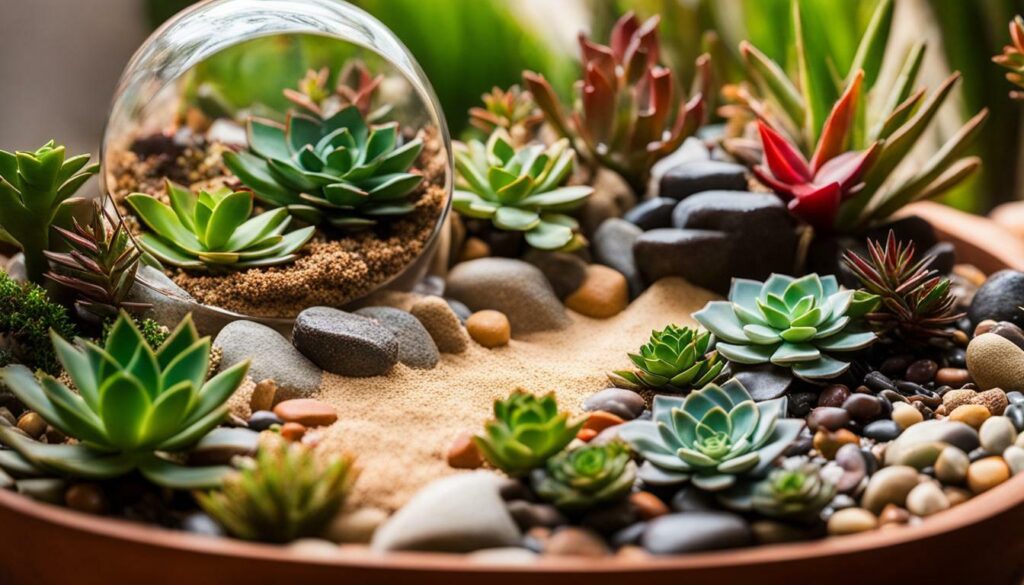
Create visual interest by incorporating different types of substrate and decor. Use a sandy substrate mixed with loam to mimic the desert soil, ensuring proper drainage for your plants. Add rocks, pebbles, or even wood pieces to create natural-looking landscapes and distinctive focal points within your terrarium.
Table 1: Recommended Desert Plants
| Plant | Description |
|---|---|
| Prickly Pear Cactus | Slow-growing cactus with paddle-shaped segments |
| Golden Barrel Cactus | Round cactus covered in golden spines |
| Blue Fescue | Tufted grass with silver-blue foliage |
| Mexican Feather Grass | Graceful, fine-textured grass with delicate seed heads |
Remember to leave some bare areas in your terrarium to mimic the sparseness of a desert landscape. This negative space adds a sense of authenticity and highlights the unique beauty of each plant. By carefully arranging your plants, substrate, and decor, you can create a visually appealing and harmonious composition that captures the essence of a desert environment.
Whether you prefer a minimalist design with clean lines or a more eclectic mix of shapes and colors, the possibilities for creating a vibrant desert terrarium are endless. Let your creativity guide you, and don’t be afraid to experiment with different combinations until you find the perfect balance. With the right design ideas and a little bit of patience, you can create a breathtaking desert terrarium that will be a focal point in any room.
Conclusion
With proper care and attention to key factors, you can create a stunning and low-maintenance desert terrarium that brings the beauty of arid landscapes right into your home. Creating a desert terrarium requires careful consideration of lighting, heating, humidity, watering, substrate, decor, and plant selection.
To mimic the arid environment of a desert, it is crucial to provide high/bright lighting using full-spectrum grow lights or place the terrarium near a bright window with indirect sunlight. In colder environments, additional heating may be necessary to maintain the ideal temperature.
Maintaining low humidity levels is essential for the success of your desert terrarium. This can be achieved by ensuring proper ventilation and using a hygrometer to monitor humidity levels. When it comes to watering, it is important to water sparingly and only when the soil is completely dry. Overwatering can lead to root rot, which can be detrimental to the plants.
Choosing the right substrate and decor is also crucial in creating a beautiful desert terrarium. Sandy substrate mixed with loam is recommended to ensure good drainage. Rocks and wood pieces can be added for visual appeal, mimicking the natural environment of a desert. Selecting slow-growing cacti, dry grasses, and drought-tolerant succulents will enhance the authenticity of your terrarium. Limiting the number of plant species and leaving bare areas will create a more natural and realistic desert landscape.
By following these guidelines and taking the time to understand and meet the needs of your desert terrarium, you can enjoy the beauty and tranquility of an arid landscape in the comfort of your own home. Embrace the wonder of desert terrariums and create a unique and captivating piece of nature within your living space.
Can the same techniques be used to maintain both desert and tropical terrariums?
Yes, the same techniques for creating tropical terrariums maintenance can also be applied to desert terrariums. Both types of terrariums require proper watering, light exposure, and temperature regulation to maintain a healthy environment for the plants and organisms within the enclosed space.
FAQ
What are the key factors to consider when creating a desert terrarium?
The key factors to consider when creating a desert terrarium are lighting, heating, humidity, watering, substrate, decor, and plant selection.
How should I provide lighting and heating for my desert terrarium?
To provide lighting, use high/bright lighting such as full-spectrum grow lights or place the terrarium near a bright window with indirect sunlight. Additional heating may be necessary in colder environments.
How do I maintain low humidity levels in my desert terrarium?
It is crucial to maintain low humidity levels in a desert terrarium. Monitor humidity levels and take steps to reduce it, such as using a dehumidifier or providing proper ventilation.
How often should I water my desert terrarium?
Watering should be done sparingly and only when the soil is completely dry. Desert plants are adapted to arid conditions and overwatering can lead to root rot and other issues.
What type of substrate and decor should I use in my desert terrarium?
It is recommended to use sandy substrate mixed with loam for good drainage. Decor options can include rocks and wood pieces to mimic a natural desert environment.
What are the ideal plants for a desert terrarium?
Slow-growing cacti, dry grasses, and drought-tolerant succulents are excellent choices for a desert terrarium. Limit the number of plant species to maintain a natural appearance and leave bare areas to mimic the sparseness of a desert landscape.
Can you provide design ideas for desert terrariums?
There are various design ideas for desert terrariums. Experiment with different arrangements of plants, decor, and other elements to create a vibrant and authentic desert landscape.

